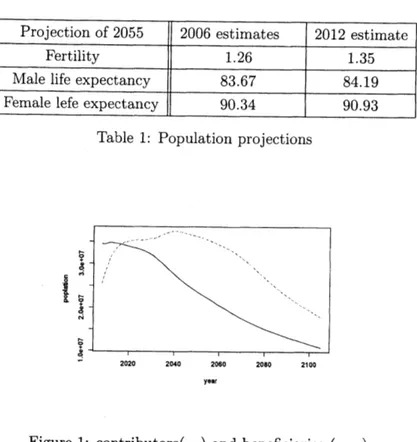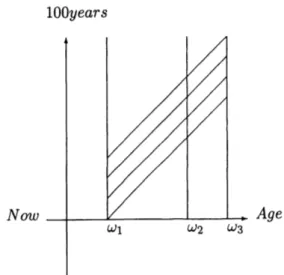A
portfolio
model for
the
risk
management
in
public
pension*
Tadashi Uratani
Department of System Engineering Hosei University
Abstract
The financial sustainability of public pension requires the reserve should be positive
to pay the benefit in the demographic and economical environment change subject to the
certain level of the income replacement ratio. Assuming the market asset and the income
for pension follows Ito processes and we maximize the net present value of pension for the
cohort, To guarantee the pension fund sustainability, we apply the martingale method of
the optimal consumption and investment theory. We use the age-structured model to the
pension population change.
Keywords: public pension, portfolio risk management, population cohort
1
Introduction
1.1
Risk management for
a
public pension
Welfare nationshave beensuffering therobust managementofpublic pension
as seen
thereformin [4] and [5]. Japanese government has announced every five years the actuarial valuation of
pension plan for 100years,
as seen
[6]. It reviewed the longterm financial viability undersignif-icant changes in the demographic and economical environment. The financial viability implies
that the
reserve
of pension fund should be positive, under the $co$ndition that the replacementratiois
more
the50%,
whichmeans
thattheaverage
amountofpensionismore
than the averageincome of contributors.
The aging society with the low birth ratemakesworsethe balance ofpensionaccount inthe
near future withthe prolonged deflationary economy in Japan.
Economic scenarios for the simulation are the rate of return of investment, the wage as the
key factorof contribution and benefit, andinflation rate and interest rate.
The total pension fund
was
144.4 trillion yen at 2009 and has decreased to 120 trillion at2012. There exists the ambiguity in population projection by Government survey [6] as Table
1.1. Figurel.1 is the governmental projections ofpopulations ofpension.
The long term economic scenarios
were
assumedas
Tablel.1. In2004thegovernment reformplan hadset the maximum premiumrate
as
18.3% and benefit cutoffby the rate ofdecreasingcontributors and aging rate. Their plan starts from 2012 and will end
2038.
1.2
$A$ portfolioformulation for pension
riskmanagement
The objective satisfies the following considerations; 1) to minimize the government subsidy
to pension fund, 2) to maximize the net present value of pension premium and benefit, 3) to
’This researchwassupportedinpart bytheGrant-in-Aid for Scientific Research(No. 25350461) of theJapan
Table 1: Population projections
yeer
Figure 1: contributors$(-)$ and beneficiaries $($ — $)$
minimize thedifferenceamonggenerations in the net values, 4) to perform income redistribution to the poor elderly.
The constraints are followings; 1) no default of pension system for 100years, 2) The
reserve
fund at the end ofplan should be enough to continue the system. 3) The income replacement
ratio should be
more
than 50%.2
The model
2.1
PolicyholdersLet $p(t, y)$ denote the numbers of policyholders of the age
$y$ at $t$ and
$\omega_{1}$ the starting age of
paying premium, $\omega_{2}$ the end ageand starting of receiving benefit
$\omega_{3}$ the end age of beneficiary.
The total number of contributors satisfies:
$\xi_{t}^{1}=\int_{\omega_{1}}^{\omega}2p(t, y)dy$ (2.1)
Thetotal number ofbeneficiaries:
$\xi_{t}^{2}=\int_{\omega 2}^{\omega 3}p(t, y)dy$ (2.2)
The balanceof total premium and benefit is assumed to bebased
on
the average wage. Let$H_{t}$ denote the average wage at $t$ and $a_{t}$ be the rate ofpremium. Let $u_{t}$ be the total premium
amount at $t$;
$u_{t}:=a_{t}H_{t}\xi_{t}^{1}$
Let $b_{t}$ be the benefit ratio to the average wage and $s_{t}$ be thetotal benefit amount;
$s_{t}:=b_{t}H_{t}\xi_{t}^{2}.$
We
assume
that $a_{t},$$b_{t}$ is predictable process and it satisfies self-finance strategies, whichare
inthe condition of$0<a_{t},$ $b_{t}<1$
.
The balance of premium and benefit $q_{t}(a, b)H_{t}$ is defined as: $u_{t}-s_{t}=(a_{t}\xi_{t}^{1}-b_{t}\xi_{t}^{2})H_{t}=:q_{t}(a, b)H_{t}.$2.2
The portfolioThe pension portfolio consists of three assets; Market asset price satisfies the following It\^o
process:
$dA_{t}/A_{t}=\mu_{r}(t)dt+\sigma_{r}(t)dW_{t}^{r}=:dr_{t},$
Humancapital price(wage) process satisfies:
$dH_{t}/H_{t}=\mu_{x}(t)dt+\sigma_{x}(t)dW_{t}^{x}=:dx_{t},$
The riskfree rate $r$ and the money market account $e^{rt}.$
Portfoliostrategies ofthe pension fund
are
denotedas
$\pi_{t}:=(\phi_{t}, a_{t}, b_{t},\beta_{t})$; Let $\phi_{t}$ denote theinvestment amount ofmarket asset, $(a_{t}, b_{t})$ denote the strategies for the human capital which
means the policy of pension. Let $\beta_{t}>0$ denote the government subsidy to pension fund at $t$
and $R_{t}$ denote the value ofpension fund at $t.$
The portfolio valuesatisfies at $t$:
$R_{t}=\phi_{t}A_{t}+q(a, b)H_{t}$ (2.3)
The dynamics offund is due to the predictability ofstrategies $(\phi_{t}, \beta_{t})$:
$dR_{t}=\phi_{t}dA_{t}+d(q(a, b)H_{t})+\beta_{t}dt, R_{0}=\overline{R}$ (2.4)
The population dynamics is assumed to be non stochastic but not satisfies self financing
condition then the dynamics of the balance of premium and benefit of pension is as follows,
$d(q(a, b)H_{t}) = a_{t}(d\xi_{t}^{1}H_{t}+\xi_{t}^{1}dH_{t})-b_{t}(d\xi_{t}^{2}H_{t}+\xi_{t}^{2}dH_{t})$
Letdefine the change of balancedue to changeof numbers ofcontributors and beneficiaries;
$dq(a, b)$ $:=a_{t}d\xi_{t}^{1}-b_{t}d\xi_{t}^{2}$, then
$d(q(a, b)H_{t})=q(a, b)dH_{t}+dq(a, b)H_{t}.$
Subsitute it to (2.4) then
$dR_{t}=\phi_{t}A_{t}dr_{t}+q(a, b)H_{t}dx_{t}+dq(a, b)H_{t}+\beta_{t}dt.$
By using (2.3) we obtain:
$dR_{t}=R_{t}dr_{t}+q(a, b)H_{t}(dx_{t}-dr_{t})+dq(a, b)H_{t}+\beta_{t}dt.$
From (2.1) and(2.2),
$dq(a, b) = a_{t}d\xi_{t}^{1}-b_{t}d\xi_{t}^{2}$
$= \{a_{t}\int_{\omega_{1}}^{\omega_{2}^{-}}\frac{\partial p(t,y)}{\partial t}dy-b_{t}\int_{\omega_{2}}^{\omega_{3}}\frac{\partial p(t,y)}{\partial t}dy\}dt$
From the PDE ofMcKendrick-von Foerster
$\frac{\partial p(t,y)}{\partial t}=-\frac{\partial p(t,y)}{\partial y}-\mu(t, y)p(t, y)$, (2.5)
where $\mu(t, y)$ is decreasing speed ofpension participant at $t$of the age
$y.$
2.3
The cohortmodeling
Weusethemethod ofcharacteristicsin PDE whichequalstouse the cohort model ofpopulation.
Let $t=k+y$ and
assume
$\mu(y)=\mu(t, y)$ whichmeans
the decreasing number depends onlythe age. Let $v(k, y)$ $:=p(t, k)$ then From (2.5) we get:
$dv(k, y)=-\mu(y)v(k, y)dy.$
and thesolution is
$v(k, y)=v(k, 0) \exp(\int_{0}^{y}\mu(s)ds)$
In Figure 2.3 is seen the cohort model in a public pension plan for 100 years horizon and the
ages ofcontribution $(\omega_{1}, \omega_{2})$ and benefit $(\omega_{2}, \omega_{3})$
.
The change of contributor is from (2.1):$d \xi_{t}^{1} = -\int_{\omega_{1}}^{\omega_{2}^{-}}\mu(y)v(k, y)dy,$
andthe change ofbeneficiaries is similarily:
$d \xi_{t}^{2} = -\int_{\omega_{2}}^{\omega_{3}}\mu(y)v(k, y)dy.$
Thus the change of pension balance satisfies ;
$dq_{t}(a, b)H_{t} = (a_{t}d\xi_{t}^{1}-b_{t}d\xi_{t}^{2})H_{t}$
$= -(a_{k+y} \int_{\omega_{1}}^{\omega_{2}^{-}}\mu(y)v(k, y)dy-b_{k+y}\int_{\omega}^{\omega_{3}}2\mu(y)v(k, y))H_{t}$, (2.6)
where$p(k+\omega_{1}, \omega_{1})$ is the
new
entry numbers of contributors and$p(k+\omega_{2}, \omega_{2})$ isthe
new
entry$100years$
Figure 2: Cohorts and 100 year pension plan
3
The
pension strategies
3.1
The presentvalue of pension
fora
cohortFor thetimehorizon from$0$ to$T$there
are
$k$cohort of$0\leq k\leq T_{l}$ $:=T-(\omega_{3}-\omega_{1})$whoare
theirall contributions and benefits
are
within the planning period. These cohortsare new
comers
tothe pension.
$c(k) :=- \int_{\omega_{1}}^{\omega_{2}^{-}}a_{y+k}H_{y+k}^{*}v(k, y)dy+\int_{\omega}^{\omega_{3}}2b_{y+k}H_{y+k}^{*}v(k, y)dy$ (3.1)
For existing pensionaries $(-\omega_{3}<k<0)$
,
their premium and benefitwas
decided as $a_{c}$ and $b_{c}$ for the past $:y+k<0$; They will follow thenew
premium and benefit fromnow
$y+k\geq 0.$The net present value $c_{e}(k)$ should be positive;
$c_{e}(k)=- \int_{\omega}^{\omega_{2}^{-}}1(a_{c}1_{\{y+k<0\}}+a_{y+k}1_{\{y+k\geq 0\}})H_{y+k}^{*}v(k, y)dy$
$+ \int_{\omega}^{\omega 3}2(b_{c}1_{\{y+k<0\}}+b_{y+k}1_{\{y+k\geq 0\}})H_{y+k}^{*}v(k, y)dy$
.
(3.2)For the future cohort $(T_{l}<k<T)$ whosebenefit willnot finished before$T$, their net present
value $c_{p}(k)$ should be positive;
$c_{p}(k)=- \int_{\omega_{1}}^{\omega_{2}^{-}}(a_{k+y}1_{\{y+k<T\}}+\tilde{a}_{y+k}1_{\{y+k\geq T\}})H_{y+k}^{*}v(k, y)dy$
$+ \int_{\omega}^{\omega_{3}}2(b_{y+k}1_{\{y+k<T\}}+\tilde{b}_{y+k}1_{\{y+k\geq T\}})H_{y+k}^{*}v(k, y)dy$
.
(3.3)The past balance ofpremium and benefit are accumulated
as
a part of the present reservefund $R_{0}$;
problem of public pension
The objective function is to maximize the utility function of the new pension participant who
are the cohort of $0\leq k\leq T_{l}$, where $U_{1}$$(.$$)$ is a utility function for present value ofpension and $U_{2}(\cdot)$ is the utility of fund value at $T$:
$\max_{\pi_{t}}E[\int_{0}^{T_{l}}U_{1}(c(k)dk+U_{2}(R_{T})]$
Beside constraints (3.2) and (3.3), we impose the following constraints seen in [5];
(1) No default of pension fund, whichshould satisfiesthe following;
$R_{t}>0 \forall t\in[0, T],$
(2) Government subsidy $\gamma_{t}$ should be within the limitation;
$E^{Q}[ \int_{t}^{T}e^{-rs}\beta_{s}ds|\mathcal{F}_{t}]\leq\gamma_{t}.$
At the planning time it is as follows;
$E^{Q}[ \int_{0}^{T}e^{-rs}\beta_{s}ds]\leq\gamma_{0}$
(3) The economic rationality to hold the pension; For the existing policyholders;
$E^{Q}[c_{e}(k)]>0, k\in(-\omega_{3},0)$
For the future policyholders;
$E^{Q}[c_{p}(k)]>0, k>T-(\omega_{3}-\omega_{1})$
4
Pension
portfolio
process under the risk
neutral
probability
4.1
Martingale method
forthe
riskmanagement
Theriskmanagement ofpensionshould be no defaultwhichimpliesthat $R_{t}>0$for all$t\in(0, T)$
.
It can be treated by the martingale method ofoptimal investment and consumption problem of
Dana-Jeanblanc $[2],ppl37-144.$
Let $e^{rt}$ a numeraire, from (2.3) and (2.4)
$dR_{t}e^{-rt}-R_{t}re^{-rt}dt=(\phi_{t}dA_{t}+q(a, b)dH_{t}+dq(a, b)H_{t}+\beta_{t}dt)e^{-rt}-(\phi_{t}A_{t}+q(a, b)H_{t})re^{-rt}(4.1)$
Then
$d(R_{t}/e^{rt})=\phi_{t}d(A_{t}/e^{rt})+q(a, b)d(H_{t}/e^{rt})+dq(a, b)H_{t}e^{-rt}+\beta_{t}e^{-rt}dt$
Let denote $R_{t}^{*}:=R_{t}/e^{rt},$ $A_{t}^{*}=A_{t}/e^{rt},$ $H_{t}^{*}=H_{t}/e^{rt}$, then
$dR_{t}^{*}=\phi_{t}dA_{t}^{*}+q(a, b)dH_{t}^{*}+dq(a, b)H_{t}^{*}+\beta_{t}e^{-rt}dt$ The
reserve
fund at $T$ becomes as follows:$R_{T}^{*}=R_{0}+ \int_{0}^{T}\phi_{t}dA_{t}^{*}+\int_{0}^{T}q(a, b)dH_{t}^{*}+\int_{0}^{T}H_{t}^{*}dq(a, b)+\int_{0}^{T}\beta_{t}e^{-rt}dt$, (4.2)
4.2
The admissible
strategies
The admissible strategies satisfying the constraint $R_{t}>0$
as
Dana et al [2]. Weassume
thatthe government subsidy to the pension fund shouldsatisfies $E^{Q[} \int_{t}^{T}\beta_{s}ds+\int_{t}^{T}H_{s}dq(a, b)]\leq 0.$
It is theassumption that the government subsidy is less than the deficit due to the population change oftheaging with low fertility. Anotherassumptionwhichis taken fromJapanese pension report isthat the final
reserve
fundcovers
the pension benefit;$R_{T}=H_{T}b_{t}\xi_{t}^{2}$ (4.3)
From (4.2)
$R_{t}^{*}- \int_{0}^{t}H_{s}^{*}dq(a, b)-\int_{0}^{t}\beta_{t}e^{-rs}ds=R_{0}+\int_{0}^{t}\phi_{s}dA_{s}^{*}+\int_{0}^{t}q(a, b)dH_{s}^{*}=:M_{t}$ (4.4)
$M_{t}$ isa positive $Q$-martingale which is under the risk neutral probability. Then
$R_{t}^{*}=M_{t}+ \int_{0}^{t}H_{s}^{*}dq(a, b)+\int_{0}^{t}\beta_{t}e^{-rs}ds$ (4.5)
Using the conditional expectation ofthe martingale
$R_{t}^{*}$ $=$
$\frac{E^{Q}[R_{T}^{*}-\int_{0}^{T}H_{s}^{*}dq(a,b)-\int_{0}^{T}\beta_{s}e^{-rs}ds|\mathcal{F}_{t}]}{M_{t}}+\int_{0}^{t}H_{s}^{*}dq(a, b)+\int_{0}^{t}\beta_{S}e^{-rs}ds$
$= E^{Q}[R_{T}^{*}-l^{\tau_{H_{t}^{*}dq(a,b)}}-l^{T}\beta_{t}e^{-rs}ds|\mathcal{F}_{t}]$
From the assumption $E^{Q[} \int_{t}^{T}\beta_{s}ds+\int_{t}^{T}H_{s}dq(a, b)]\leq 0.$ $H_{t}^{*}$ is $Q$-martingale then $E^{Q}[H_{T}^{*}]=$
$H_{0}>0$
.
Therefore the theterminalreserve
$E^{Q}[R_{T}^{*}]>0$ by (4.3). From these two conditions $R_{t}>0, \forall t\in(0, T)$and
$E^{Q}[R_{?}^{*}- \int_{0}^{T}H_{s}^{*}dq(a, b)]\leq B_{4}+\gamma 0$
We restate the above
as
the following theorem;Theorem 1
if
$E^{Q[} \int_{t}^{T}\beta_{s}ds+\int_{t}^{T}H_{s}dq(a, b)]\leq 0$ andif
thefinal
reserve
satisfies
$(4\cdot 3)$,
then$R_{t}>0, \forall t\in(0, T)$
4.3
The optimal problemFrom theconsequenceof (4.3), set the objectivefunction as
$\max_{\pi_{t}}E[\int_{0}^{T_{l}}U_{1}(c(k))dk].$
Thefirst constant is
$E^{Q}[R_{T}^{*}- \int_{0}^{T}H_{s}^{*}dq(a, b)]\leq R_{0}+\gamma_{0}.$
Define the Radon-Nikodim derivative for the risk neutral measure: $L_{t}=dQ/dP|_{\mathcal{F}_{t}}$ then the
constraint becomes under the original probability measure;
$E[L_{T}R_{T}^{*}- \int_{0}^{T}L_{t}H_{s}^{*}dq(a, b)]\leq R_{0}+\gamma_{0}$
The third constraints are For the existing policyholders;
$E^{Q}[c_{e}(k)]>0, k\in(-\omega_{3},0)$
For thefuture policyholders;
$E^{Q}[c_{p}(k)]>0, k>T-(\omega_{3}-\omega_{1})$
This optimal problem willbe solved in discretized version.
References
[1] Clark, C. W.,(2010): Mathimatical Bioeconomics, John Wiley
[2] Dana,R-A., Jeanblanc, M.,(2007): Financial Markets in Continuous Time,Springer Finance
[3] Kot, M.,(2001): Elementsof Mathematical ecology, Cambridge University press
[4] Bundesministerium f\"ur Albert und Soziales,(2005):
\"Uberblick
\"uber das Sozialrecht[5]
WAifltf
$\{\Phi’k^{\backslash }ffi\ovalbox{\tt\small REJECT} \mathscr{X}\Phi^{\overline{\overline{-}}}\ovalbox{\tt\small REJECT},$ $*\pi$2 $1\not\in \mathbb{R}ffli\mathfrak{N}\Re_{I}^{\overline{E}}g\varphi_{\mathfrak{o}^{b}}\ovalbox{\tt\small REJECT}\triangleright,\dagger^{o}\backslash -k$[6] $\ovalbox{\tt\small REJECT}\xi E9?\ovalbox{\tt\small REJECT}’g^{\backslash }\not\in\Leftrightarrow\ovalbox{\tt\small REJECT} \mathscr{X}\Phi^{-}\ovalbox{\tt\small REJECT},$ $\ovalbox{\tt\small REJECT}\#\not\in\not\in\cdot$
Department of System Engineering
Faculty ofScience
&
EngineeringHosei University, Koganei 184-8485, Japan
$E$-mail address: uratani@hosei.ac.jp
$\mathfrak{F}\infty X\ovalbox{\tt\small REJECT}$

